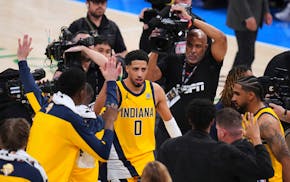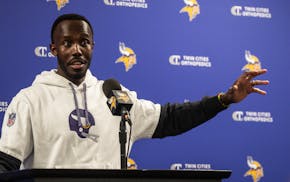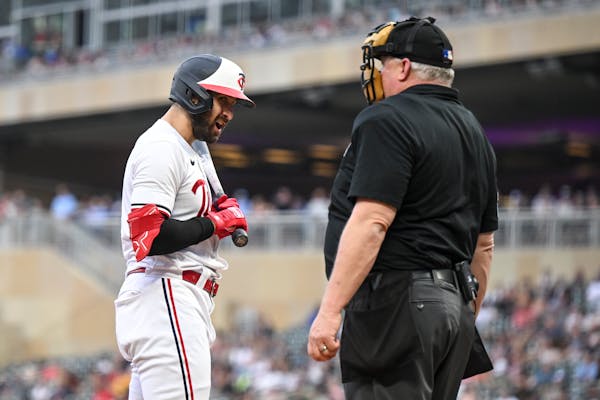Donovan Solano remembers that devastating trudge back to the dugout, the shame he felt as a boy playing baseball in his hometown of Barranquilla, on the Caribbean coast of Colombia, whenever he struck out.
"I remember sometimes crying when I strike out. You feel so bad walking away," Solano said. "You want so much to do good things, but you have to deal with it. It was hard."
Whew. Just imagine the Twins' Kleenex budget if that was a typical reaction today.
On Sept. 6, with the Twins trailing the Guardians 2-1 in the top of the sixth inning and Max Kepler on first base, Carlos Correa swung over the top of a two-strike curveball from Sam Hentges that broke in on him. Correa marched back to the dugout, unaware he had made some ignominious team history: It was the 1,431st strikeout of the season, more than any Twins team has ever whiffed.
"Nobody wants to strike out, but it's part of the game," Correa shrugged. "Strikeouts happen."
Sure do — a lot. More this year than ever before, and more in Minnesota than anywhere else. The Twins have gone down on strikes 1,535 times, the runaway MLB leader this year and already the 15th-most by a major league team. And at their current pace of 10.3 strikeouts per game, they will shatter the Cubs' two-year-old record of 1,596 whiffs by more than 70.
The Twins strike out in 27% of their at-bats.
"We've talked about it, [but] I am not concerned about setting a record or anything along those lines," Twins manager Rocco Baldelli said. "We've had a pretty good second half, offensively. We've struck out, and we've still scored a bunch of runs. So I'm not focusing on the number of strikeouts we have. I'm focusing on the number of good at-bats we have."
The Twins have indeed revved up their offense since the All-Star break, scoring more runs than any American League team but Houston. And they have done it while striking out more than 600 times, the only team in the majors to surpass that milestone.
Historic numbers
By all sorts of measures, the 2023 Twins are extraordinary at, well, not hitting. They have already reached double-digit strikeouts in 85 games, more than half their schedule; never before had that number exceeded 66 games. They have suffered 14 or more strikeouts in 23 games this year, or more than their total of any two seasons previously.
All nine players in their starting lineup have struck out in a game 11 times this season; last year, it happened only twice. They have already set new franchise records for strikeouts by designated hitters (207), left fielders (187) and leadoff hitters (193).
But does any of that matter? Should the Twins feel like crying over all the swing-and-misses?
"No! We're in first place, you know? It's part of the game — sometimes we try too much," said catcher Christian Vázquez. "We're in a good place, playing very good baseball. It's how many runs you get, not how many strikeouts, that's all that matters."
Despite all those balls not put in play, he's right, the Twins are scoring runs. They are on pace to reach 750 or so, just short of being one of the 20 best seasons in their history.
They are also headed toward the second-best home run season in Twins history, roughly 230 by season's end — and that's far more important, Derek Falvey pointed out.
"In today's game, there's no more highly correlated stat to scoring runs than getting power. Power is the most important thing in today's game, and has been for a long time," said Falvey, the Twins president of baseball operations. "It was never our goal to set any records like that, right? But strikeouts come with slugging percentage. This has been a really good offensive club for the past couple of months, one that gives us a chance to win, strikeouts or not."
Pitchers dominating
Over the winter, Falvey traded Luis Arráez, who struck out in only 7.1% of his plate appearances, one of the lowest strikeout rates in team history, and signed Joey Gallo, whose career whiff rate of 37.9% is one of the highest in major league history. So it's no surprise that the team's numbers have spiked.
Especially in this era of specialized pitching. That's the biggest change that Vázquez sees, teams harnessing technology to help their pitchers throw harder and with greater spin on the ball.
"The pitchers are so nasty now. Breaking balls are bigger, fastballs are thrown harder," said Vázquez, who as a catcher has a unique view of the improvement. "This game is getting harder and harder every year. I feel like the game was just easier, only two years ago."
That fact hasn't lessened the willingness to accept strikeouts as a byproduct of more slugging.
"The percentage of quote-unquote offspeed pitches that are 90 mph or greater just keeps growing. So it's really hard to get four to five hits off of that in a given inning in order to score a run or two," Falvey said.
"The reality of run-scoring now is: get on base, maybe one bleeder that gets through or some kind of hit, a walk, and then a three-run homer. That's the fastest and most likely way [to score]. Look at the teams with the fewest strikeouts [the Guardians and Nationals, each of whom have scored fewer runs] — which offense is more likely to win games, now and in the postseason?"
Other side of the coin
Besides, Falvey points out, the 2023 Twins will set another strikeout record, too — the most ever recorded by their pitching staff in a single season, a number that will exceed 1,500 for the first time.
Fifteen MLB teams strike out more than 23% of the time this season, and 15 strike out less. The Twins are at 27% with Gallo (42.8%), Michael A. Taylor (33.3%), Matt Wallner (32.1%), Edouard Julien (31.5%) and Byron Buxton (31.4%) highest among regular players.
The Twins are aware of their batters' strikeout numbers, of course, and held team meetings about it, even debated changing philosophies earlier this season, Solano said, when their problems hitting with runners in scoring position were especially pronounced.
"We said we needed to do something, make more contact, just not try to hit a homer in that situation because you don't need one. Sometimes you swing too hard," Solano said. "But we never let the strikeouts take over. We worked it out."
He counts himself in that, even though he's still bothered — just not to the point of tears — when he strikes out.
"I know this year I strike out more, and I don't know why. I'm not thinking on two strikes, 'I can't strike out, I can't,' " said the veteran infielder, whose 92 whiffs and 22.3% strikeout rate are career highs.
"Our mindset is, do damage. Hit it hard. Maybe it's that. Maybe it's something we work on. I promise, I'm trying not to strike out, but it happens. If we win, it doesn't matter."
Walking away empty
Twins players and their strikeout percentages. The number is the percent of plate appearances in which the player fanned, through Friday.
Joey Gallo 42.8%
Kyle Garlick 36.7%
Trevor Larnach 35.6%
Michael A. Taylor 33.3%
Matt Wallner 32.1%
Edouard Julien 31.5%
Byron Buxton 31.4%
Ryan Jeffers 29.2%
Alex Kirilloff 25.9%
Kyle Farmer 25.5%
Jorge Polanco 24.7%
Willi Castro 24.0%
Jordan Luplow 23.7%
Royce Lewis 23.0%
Christian Vázquez 22.8%
Carlos Correa 22.8%
Andrew Stevenson 22.7%
Donovan Solano 22.3%
Max Kepler 21.8%
Jose Miranda 15.8%
Nick Gordon 11.8%
Source: fangraphs.com
A trend of late ...
Major league highs for team strikeouts in a season, listed with the team's final record. The Twins are on pace for 1,665 in 2023. Seattle — another team contending for a playoff spot — is also on pace to surpass 1,600 K's.
2021 Chicago Cubs: 1,596 (71-91)
2019 Detroit Tigers: 1,595 (47-114)
2018 Chicago White Sox: 1,594 (62-100)
2019 San Diego Padres: 1,581 (70-92)
2019 Seattle Mariners: 1,581 (68-94)
2019 Texas Rangers: 1,578 (78-84)
2017 Milwaukee Brewers: 1,571 (86-76)
2019 Milwaukee Brewers: 1,563 (89-73)
*Twins: 1,535 with 13 games remaining

Softball state tournament: Live updates from championship games at Jane Sage Cowles Stadium

Podcast: How the Pacers taught the Thunder (and the Wolves) a playoff lesson
Yuen: How success has pushed Minnesotans off sidelines in trans athlete debate
David Festa's return to Twins goes south in a hurry


